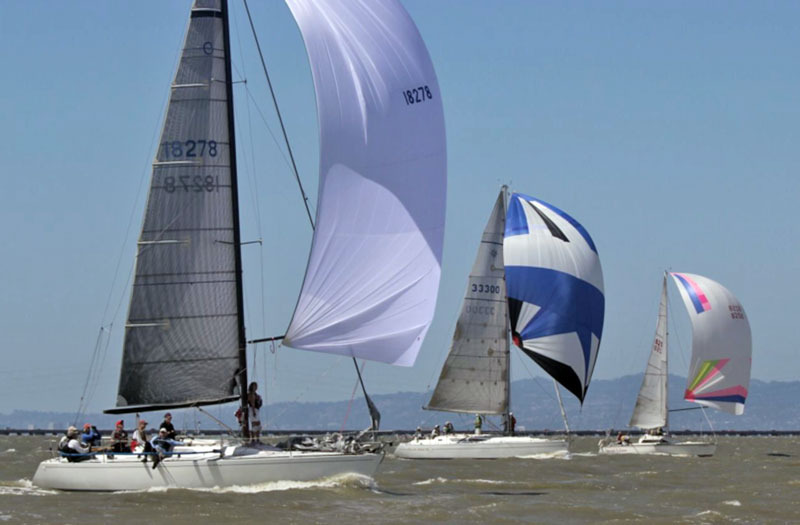
New Crew Learn to Race
This spring, an innovative experiment proved successful in opening up sailing on the South Bay to more people. The experiment was a three-week class for potential race crewmembers. My own first experience as race crew was rather daunting. I signed up for a race from San Francisco to Monterey on a high-performance 50-footer. Despite having 20 years of cruising experience plus some small boat racing, I found ocean racing on a large keelboat to be quite different. Hiking out on the rail was new. The boat was more complex. Crewmembers had specific roles. Four hours into the race, when I started to unwrap my lunch sandwich, the crewmember next to me said, “I wouldn’t do that now, if I were you.” “Why?” “Because the tactician will call for a tack before you finish your sandwich, and you will have to drop it!” The crewmember was correct. The experienced crew knew what to expect.
The idea of a beginner crew class was to demystify sailboat racing for the uninitiated. The format included three classroom sessions, followed by three beer can races in which class members were assigned to different boats. Week one was about yacht racing in general: race formats, racing rules, crew positions, tactics and safety. Week two was about the upwind leg. The upwind theme was “Go fast in the right direction.” Concepts like “velocity made good” were explained, and the goals for each position on the team were described. Week three was about the downwind leg. The downwind theme was “Go fast in the right direction and get there without mishap!” The differences between asymmetric and symmetric spinnakers were explained, followed by discussion of the things that can go wrong while flying a spinnaker: wraps around the forestay, round-ups, round-downs and shrimping. Twenty-five students participated.
What are skippers seeking in good crew? We polled the 16 boats, and the answers varied considerably. Here are some of the responses:
- Sails consistently and learns quickly, past racing competency a big plus.
- Talent.
- Nimbleness…quick from rail to rail.
- Not overly competitive; doing your best more important than winning.
- Physically smaller/slim (smaller boat).
- Interested in (and open to) learning.
- Consistency. Need crew continuity to build good teamwork and individual skills.
- Good attitude, eager to learn and help out, dependable, strong and agile enough to help out.
Since most skippers were crew at times, we also asked what characteristics were desirable in a skipper. Here are some of the responses:
- Moderate tolerance for error and shows care for crew morale.
- Communicative and in command but not abusive in stress.
- Appreciates crew inputs but acts competently on tactician’s call.
- Lets people try new things.
- Does well in races.
- Being calm and cool in difficult situations; no screaming or swearing — it never helps.
There was a brief session on the Racing Rules and basic crew safety, including a suggestion that every crewmember experience an in-the-water test of the normal gear they wear. “Going overboard can be a shocking experience. Finding out the PFD you wear cuts off your breathing when worn improperly and the auto-inflator deploys can ruin your day,” said Phillip Meredith during his briefing. Several in the class practiced an in-the-water test and consequently made changes to their sailing gear.

The fun part was the racing. Sequoia Yacht Club runs an informal race each Wednesday, sailing out to the Bay from the turning basin in the Port of Redwood City to a designated mark selected based on conditions. Here are some of the student reactions to their race participation adventures:
Karen Fryling wrote: “My ‘maiden sail voyage’ and I couldn’t have picked a better skipper myself. I had a blast!”
Maggie Heilman wrote: “This class provided a fabulous opportunity to experience three completely different boats and teams, and each was fantastic. Starting with a Merit 25, I had my first opportunity to be the main trimmer; having control of the boat gave me an inner confidence that I hadn’t previously experienced. My second boat was a super-fast multihull racing boat, the Dragonfly 25; it was my good fortune to be out on the day with 29-knot winds, and we were flying at over 17 knots. Thrilling! Who knew masts could rotate? On purpose! My third boat was smaller, a J/70. With a simple crew of three, my position was main trimmer; the experience from my first sail provided me some reassurance as we sailed in heavy winds. Of course the skipper was watching and aware at all times with his hand on the main.”
Scott Scherer, Sequoia’s rear commodore, had this observation: “When Stan Phillips introduced the idea of his New Crew Orientation class, I was intrigued at the prospect and potential that it held. The Sequoia Yacht Club Board of Directors, as well as the entirety of our racing organization, had no idea the popularity this course would have amongst both new racers and veteran skippers/crews. I think it is safe to say we all look forward to the next edition.”
As the instructor, I found the class was fun to teach and the enthusiasm of the students gratifying. Perhaps there will be an encore soon.
